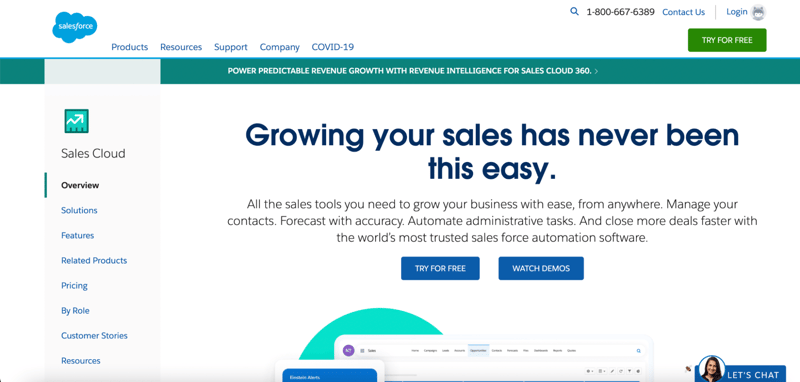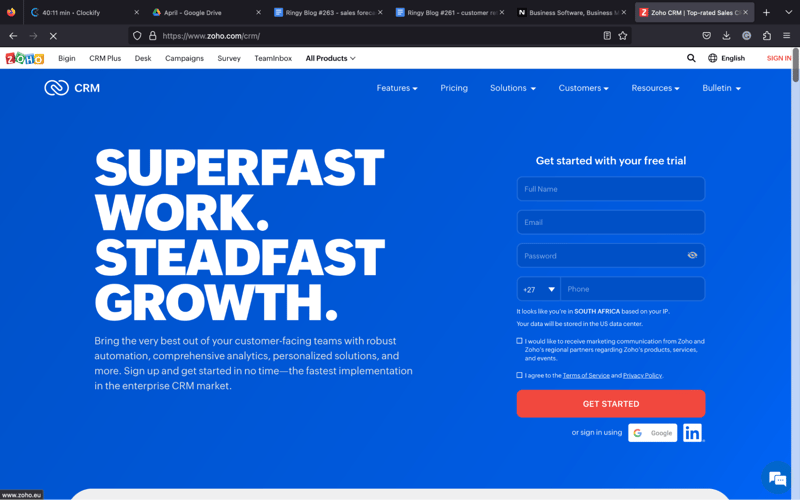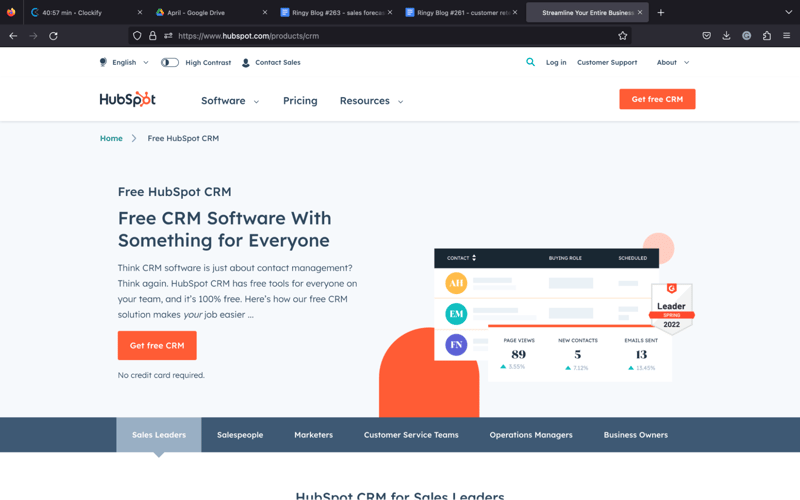
Sales Forecast Methods: A Complete Guide
 Updated on
Updated on
 By Carlos Correa
By Carlos Correa
Carlos Correa
Carlos has been involved in the sales space for well over ten years. He began in the insurance space as an individual sales agent, managing teams as s...
learn more
Carlos Correa
Carlos has been involved in the sales space for well over ten years. He began in the insurance space as an individual sales agent, managing teams as s...
Table of Contents
Table of Contents
Hitting revenue targets and getting an accurate sales forecast to go together like milk and cereal.
However, with the plethora of sales forecast methods, figuring out which approach will provide the most detailed view may be challenging.
This article covers how to forecast sales, applying sales forecast methods and formulas, highlighting why you should forecast sales, the benefits, keys to success, challenges, features, and the top forecast tools to use.
For business proprietors wondering, “how do you forecast sales?”
Let's jump in!
How to Forecast Sales

Predicting future sales revenue for a business is becoming increasingly important. With multiple companies fighting for dominance in a competitive market, it makes sense that organizations explore different sales forecast methods.
How to calculate sales forecast for a new business requires that you follow this general guideline:
- Gather historical data - The first step to building a sales forecast is to gather historical sales data. This information should include sales figures from the past year or before, broken down by market segment, product, or any other relevant category. With in-depth sales data, the accuracy of forecasts increases significantly.
- Identify seasonality and trends - Seasonality refers to regular cyclical changes in sales, while trends refer to long-term changes in sales patterns. Understanding both of these nuances is essential when creating sales forecast methods.
- Analyze market trends - Analyzing industry trends, competitor activity, and economic indicators are excellent ways to analyze market trends. By understanding market trends, businesses can identify potential threats or opportunities that impact their sales forecast methods.
- Invest in CRM - Customer relationship management software helps companies streamline their workflow and automate tedious tasks. A CRM system also stores sales and customer data, allowing users to retrieve information within seconds.
- Utilize a sales forecast method - Many sales forecast methods are available, including quantitative and qualitative forecasting combinations.
- Review and adjust the sales forecast method - Once the sales forecast has been established, reviewing and adjusting it regularly is critical. This may involve incorporating new data as it becomes available, adjusting for changes in market conditions, and comparing actual sales figures with the sales forecast.
With this basic framework, companies can create reliable and accurate sales forecast methods that assist them with making informed decisions about resource allocation and strategic planning.
Overview of Sales Forecast Method
The primary benefit of sales forecast methods is that it allows organizations to forecast future revenue over specific periods. Therefore, the business can develop plans or projects based on this information, ultimately contributing to the company's growth.
The number one consideration in sales forecast methods is sales targets. Each sales team or representative should be assigned a minimum number of sales to close each month to bring the company closer to its goals and objectives.
Sales forecast methods allow businesses to set objectives precisely. Thanks to realistic, pinpoint goals, sales teams contribute to the organization's success and work more efficiently.
Standard Sales Forecast Formulas

Business planning and sales forecast methods go hand in hand, helping organizations to predict future sales performance and make intelligent decisions about growth opportunities, marketing strategies, and financial forethought.
Utilizing different techniques and formulas, sales forecast methods can vary depending on the company's needs, resources, and data availability.
Let's explore some of the most common sales forecast formulas businesses utilize.
The Straight Line Sales Forecast Method
One of the most popular and straightforward sales forecasting formulae is this one. According to the straight-line technique, sales will increase at a consistent rate throughout time, and this rate may be calculated by looking at previous sales data.
The straight-line method's formula follows this outline:
- Projected Sales = Last Year's Sales + (Sales Growth Rate × Last Year's Sales)
- If a business generated $500,000 in sales last year and expects sales to grow by 10% this year, the projected sales for this year would be:
- Projected Sales = $500,000 + (10% × $500,000) = $550,000
The straight-line sales forecast method is easy to use and requires no complex calculations or software. It can be done manually with a simple graph and calculator.
However, there are also limitations to the straight-line sales forecast method. One significant restriction is that it assumes that sales will continue to increase or decrease linearly, which may not be accurate if external factors such as economic or competition changes affect sales.
Moving Average Method
This statistical strategy, called the moving average method, involves averaging past sales data over a given period. Businesses can use this technique to find trends that influence future sales estimates and smooth out volatility in sales performance.
The formula for the moving average strategy is:
- Projected Sales = (Total Sales for Previous n Periods) / n
- Forecasting sales for the next quarter using a three-month moving average requires calculating the average sales for the previous three months and using this figure as the projected sales for the next quarter.
The moving average technique is beneficial in removing noise or short-term oscillations from the data so that longer-term patterns may be more easily detected. For best results, it's recommended to utilize this methodology in conjunction with other strategies and adjust for external factors that may affect the data.
Trend Projection Method
The trend projection technique is a sales prediction methodology that assumes that sales will increase or decrease over time linearly or exponentially. This methodology frequently employs extensive past sales data and anticipates long-term sales performance.
The formula for the trend projection method is:
- Projected Sales = a + bx
- Where: a = the y-intercept of the trend line b = the slope of the trend line x = the time being forecasted
- Suppose an organization wants to forecast sales for the next five years using the trend projection method. In that case, historical sales data is utilized to calculate the y-intercept and slope of the trend line, and then those figures are used to forecast sales for each of the next five years.
The trend projection method is especially helpful for long-term forecasting since it can spot trends that might not be visible in more immediate time frames. By fitting a periodic trend line to the data, this approach may also be used to anticipate cyclical patterns or seasonal trends.
Seasonal Index Method
The seasonal index approach considers the variations in sales performance many organizations encounter. This technique analyzes historical sales data to determine the seasonal trends affecting sales.
The formula for the seasonal index method is:
- Projected Sales = Average Sales for the Current Season × Seasonal Index
- If enterprises sell more products in the summer than in the winter, they will use a higher seasonal index for the summer months to forecast sales for the upcoming season.
The seasonal index method is a valuable technique for forecasting future values based on seasonal patterns in the data. However, this approach could miss unexpected data changes or anomalies, such as a sharp rise or fall in sales due to a singular event.
Benefits of a Sales Forecast Tool

Sales Planning
Reliable and accurate sales forecast methods allow businesses to make efficient plans regarding their sales. The success of an organization depends on the success of its sales. With the ability to predict future sales performance and operation outcomes, business proprietors can plan for other efforts, such as promotions and marketing activities.
Production Planning
Excellent production planning is the consequence of an effective sales plan. Knowing how many products to produce is shown to businesses when they know how much they will sell.
A new product sale forecast tells you how many items need to be manufactured, not more or less. It's financially advantageous for organizations to be aware of these numbers to plan production for the inventory that can be successfully sold. Stockout and overstock situations can be avoided with effective production planning.
Purchasing
After production is planned, preparing to buy the items required is the next step. Using sales forecasting tools to determine what must be purchased can help eliminate over and underspending.
Reduced Inventory Costs
With sales forecasting software, businesses can avoid spending on excess inventory because they have accurate information on the number of materials to purchase. Not only is under and overspending mitigated, but accurate inventory levels positively impact other operational areas, such as warehouse cost reduction.
Reduced Warehouse Costs
With the correct inventory quantities, business owners will see other reduced costs. Warehouse costs are one of the largest areas you'll notice a significant impact. The warehouse can run more efficiently since excess inventory does not require management.
Companies have witnessed successful shipment procedures, higher turnover rates, and more. Warehouses don't have to scramble to make do because there are sufficient products to meet orders demand.
Effective Labor Management
All these cost-saving escapades sound great, don't they? However, employees are the one common attribute involved in each operation.
Your warehouse's operational upgrades enable you to manage labor much more effectively. The right workers can be hired; you only need to plan and pay for the necessary labor hours.
Performance Tracking
With retail sales forecasting, you can track employee performance across the organization. Not only do companies experience improvements in labor management, operational costs, and production planning, but they locate potential areas to improve performance.
Challenges of Creating a Sales Forecast

A Lack of Predictive Data
Customer relationship management is prevalent in sales businesses. However, many sellers loathe entering information in a CRM platform as it takes away from selling and is seen as an administrative task.
This often results in low-quality CRM data.
Here are a few data challenges businesses face:
- Insufficient historical data - A lack of historical data makes creating a reliable sales forecast arduous. With sufficient data, it may be easier to identify patterns and trends in sales performance that inform future projections.
- Changes in market conditions - Unforeseen changes in market conditions, such as economic downturns, new competitors, or changing customer preferences, can significantly impact sales performance. When creating a sales forecast, it's essential to consider these external factors and adjust projections accordingly.
- Limited data accuracy - Inaccurate data can lead to inaccurate forecasts. Sales forecasts rely heavily on accurate data about past sales and market conditions. If the information is incomplete, outdated, or unreliable, it can result in flawed predictions that do not reflect actual sales performance.
Low-quality data means more than short-term pain for current deals. In the long run, it messes with the company's sales forecasting because it lacks historical information to feed predictive patterns.
Seller Subjectivity
This age-old problem is caused by sellers relying more on their intuition about an opportunity's likelihood than factual information.
However, intuition is frequently mistaken; hence more than 40% of sales operations leaders cited seller subjectivity as their top obstacle to accurate forecasting.
Below are a few objectives sellers run into when developing their sales forecast methods:
- Biases and assumptions - Sales forecasts can be influenced by a seller's predispositions, beliefs, and personal opinions. These factors can lead to overestimating or underestimating sales figures while negatively impacting the accuracy of the forecast.
- Lack of objectivity - Sellers may rely too heavily on intuition and subjective judgment rather than empirical data without an objective approach to creating a sales forecast. This might lead to estimates based on inaccurate data or subjective opinions rather than good research.
- Inconsistent methods - Different salespeople use different techniques or criteria for creating sales forecast methods, leading to unreliable projections. Establishing a consistent and standardized sales forecasting approach that accounts for market conditions and individual seller performance variations is essential.
Although a seller's gut feeling is useful, it isn't a completely reliable source of information regarding sales forecasting. When it comes to opportunities that are nearly closed, sellers are frequently too subjective, especially as their time to sell is getting shorter and shorter.
Technology Limitations
Sales organizations are notorious for the number of technological tools they utilize. The primary challenge with software and sales forecasting stems from the lack of integration and planning.
Technology limitations produce the following challenges:
- Incomplete or unreliable data - Sales forecasting relies on accurate and complete data. However, technical limitations such as data entry errors, missing data, or outdated data can produce unsatisfactory results.
- The complexity of data analysis - Sales data can be complicated to analyze without the proper tools and technology. Manual data analysis can be time-consuming and prone to human errors. At the same time, outdated or insufficient technology may not handle the volume or complexity of data required for accurate sales forecasting.
- Dependence on technology - Over Reliance on technology also presents challenges when creating sales forecasts. Technical issues such as system downtime, cybersecurity threats, or software errors can disrupt sales forecasting processes, leading to delays or inaccuracies in projections. Therefore, contingency plans are required to minimize the impact of technology limitations on sales forecasting.
Most companies have a sales tech stack integrated with applications they already use, including CRM software. However, if employees aren't trained correctly or the integration is not seamless, sellers may struggle to perform daily tasks or record customer and sales information.
Features of Effective Sales Forecast Software

Create Reports
Forecast accuracy, project revenue, and final forecast reports are crucial to predicting future sales figures.
The table below highlights some core advantages of creating reports within your forecasting software.
|
Benefits of Creating Reports in Sales Forecasting |
Explanation |
|
Provides a visual representation of sales data |
Reports give sales data a clear, straightforward visual representation, making it simpler to see trends and patterns in sales performance. |
|
Identifies trends and patterns in sales performance |
With reports, you may find trends and patterns in sales performance, e.g., seasonal shifts, changes in a customer's behavior, or the effects of a marketing campaign. |
|
Allows for informed decision-making based on data |
Sales teams may use reports to get the data they need to make data-driven choices. Teams may increase sales performance and accomplish corporate objectives by studying sales data to spot trends and patterns. |
Ensure the forecasting software you selected can create various reports to help you get a broader picture of the organization's overall performance.
View Sales Pipeline Activity
The sales pipeline is where all a business's lead moves through. Viewing the funnel to determine how prospects are progressing through it is critical. Sales teams can also identify potential bottlenecks requiring attention or affecting future sales outcomes.
Import Internal Sales Data
You can only use the data that your software can access to make predictions. To import all the necessary internal sales data, make sure the forecasting software integrates with the tools you use to track sales, such as Excel, your accounting software, or an ERP system.
Integrate Third-Party Sales Information
Historical sales patterns and third-party sales data must amalgamate with your sales forecasting software.
The table below showcases two benefits of integrating third-party sales information into your sales forecast software:
|
Advantages of Integrating Third-Party Sales Information |
Explanation |
|
Provides a comprehensive view of market trends |
Third-party sales data can provide a complete picture of market trends, enabling businesses to make more accurate forecasts. |
|
Enables comparison with industry benchmarks |
Integrating third-party data allows organizations to benchmark their performance against industry standards while identifying areas for improvement. |
Things such as seasonal trends are utilized to create more accurate sales forecast methods that mirror the current selling environment. With the integration of sales data from multiple channels, it becomes easier to make more accurate predictions.
Track Progress Against Company Sales Goals
Importing actual sales data from accounting software can help you track your performance against the business's sales goals. This crucial feature must be included in any sales forecasting application.
Top 3 Sales Forecast Software
Salesforce Sales Cloud

Sales Cloud is a powerful sales forecast software offering a comprehensive range of forecasting tools. It provides users with an intuitive and user-friendly interface, which makes it easy to create, manage, and track sales forecasts. Teams can also create sales quotas and analyze sales performance using Salesforce Sales Cloud.
Pros:
- Robust sales forecasting capabilities - Salesforce Sales Cloud offers advanced sales forecasting capabilities, making it easy for businesses to predict future sales trends accurately.
- Advanced sales-related features - The software provides a range of sales-related features, including lead management, opportunity tracking, and customer relationship management, which can help businesses streamline their sales processes.
- User-friendly interface - Salesforce Sales Cloud is known for its user-friendly interface, which makes it easy for users to navigate and use the software.
- Mobile app availability - The program is available on mobile devices, allowing users to access their sales forecasts and related data.
Cons:
- High pricing - Salesforce Sales Cloud is one of the market's most expensive sales forecast software, making it a less viable option for small and medium-sized businesses.
- Steep learning curve - The sales forecasting platform may be challenging to navigate and understand for users who are not familiar with it.
Businesses of all sizes can manage their sales operations and expand their client base with the robust and adaptable Salesforce Sales Cloud CRM platform. Although it might not be the cheapest choice, it offers several features and customization possibilities that make it suitable for the requirements of many enterprises.
Zoho CRM

Zoho CRM is a popular sales forecast software that provides users with various sales-related features. It allows users to create sales forecasts, set targets, and analyze sales performance. Zoho CRM also offers tools for lead management, contact management, and customer relationship management.
Pros:
- Affordable pricing - Zoho CRM is one of the most affordable sales forecast software available in the market, making it a popular choice for small and medium-sized businesses.
- Easy integration with other Zoho products - Zoho CRM seamlessly integrates with other Zoho products, allowing businesses to use various tools in a unified system.
Cons:
- Limited customization options - The software has limited customization options, which may not suit the needs of all organizations.
- Some features are not available in the lower-priced plans - Features, such as advanced analytics, campaign management, and surveys are not available in the lower-priced plans.
Zoho CRM is an excellent platform for businesses looking to improve their sales forecasting. Its features, tools, affordability, and user-friendly interface make it an ideal choice for businesses of all sizes and industries. Whether you're a small business owner or a sales manager at a large corporation, Zoho CRM can help you forecast your sales accurately and drive revenue growth.
HubSpot CRM

HubSpot CRM is a free sales forecast software that provides users with the features they need to make accurate predictions. It enables users to define goals, anticipate sales, and evaluate sales activity. HubSpot CRM also offers tools for lead management, contact management, and customer relationship management.
Pros:
- Free pricing - HubSpot CRM is free to use, making it a popular choice for small businesses.
- Predictive lead scoring - HubSpot CRM uses machine learning algorithms to score and prioritize leads based on their likelihood to convert into customers. This can help businesses focus their sales efforts on the most promising prospects, improving the accuracy of their sales forecasting.
- Customizable dashboards - The platform lets businesses create customized dashboards that display key performance indicators (KPIs) relevant to their sales forecasting, including lead volume, conversion rates, and revenue growth.
Cons:
- Limited customization options - HubSpot CRM has limited customization options, which may not suit the needs of all businesses.
- Limited features in the free plan - The free plan offers limited features, and businesses may need to upgrade to a paid plan to access all the features.
Those looking to improve their sales forecast methods should look at HubSpot CRM. With multiple features and integration possibilities, the software is ideal for businesses getting started with sales forecast methods.
FAQs
How to Calculate Sales Forecast?
Various techniques may be used to produce sales projections, including trend analysis, market research, historical data analysis, and statistical forecasting. These approaches can assist you in determining the future demand for your goods or services and estimating the anticipated income for a specific time frame.
How to Forecast Sales Using Historical Data?
With past data, you may forecast sales using the time-series analysis approach. This entails studying sales data from the past to detect trends, patterns, and seasonality.
After these indicators have been found, you may utilize them to forecast upcoming sales.
Moreover, you may anticipate sales based on previous data using statistical forecasting techniques like moving averages or exponential smoothing.
What Is a Rolling Forecast?
A rolling forecast is a technique for predicting sales in which the strategy is updated regularly, usually as a quarterly or monthly sales forecast. Businesses can modify their sales prediction using a rolling forecast in response to new information and market developments. This aids organizations in being flexible and adaptable to changes in the commercial environment.
How Can I Improve My Sales Forecasting Accuracy?
You may utilize various sales forecast methods to increase the accuracy of your prediction, then compare the outcomes to determine which projection is the most accurate. To increase forecasting accuracy, you may also utilize predictive analytics and machine learning techniques.
Moreover, to ensure that it accurately represents changes in the market and your company's success, you should constantly examine and revise your sales forecast methods.
Sales Forecast Methods - Final Thoughts
Remember that sales forecasting doesn't need to be an arduous process. Anyone can do it, and as a business owner, you are the most qualified to do it for your organization.
By understanding the market and customers, you can effectively forecast sales while planning for future growth. Ensure you test various sales forecast methods to discover which works best for your company's requirements.
Streamlining customer relationship activities can help build a stronger brand and improve your sales forecasting results. Ringy is a tool developed on what matters most - communication between your team and clients.
The software offers a centralized database for customer relationship management tasks and helps bring your sales forecast methods to life.
Request a demo to learn how Ringy provides you with the relevant date for your next sales forecast.

Skyrocket your sales with the CRM that does it all.
Calling? Check. SMS? Check. Automation and AI? Check. Effortlessly keep in touch with your customers and boost your revenue without limits.

Take your sales to new heights with Ringy.
Sales in a slump? Ringy gives you the tools and flexibility you need to capture leads, engage with them, and turn them into customers.
Subscribe to Our Blog
Enter your email to get the latest updates sent straight to your inbox!
Categories
Related Articles



































































































